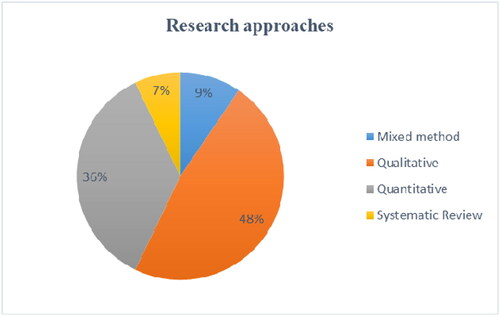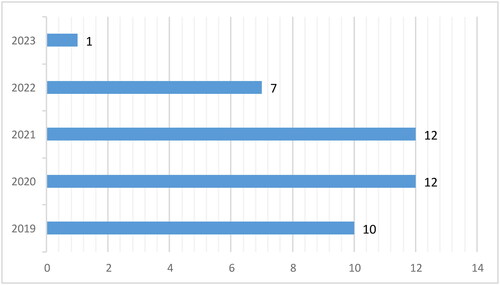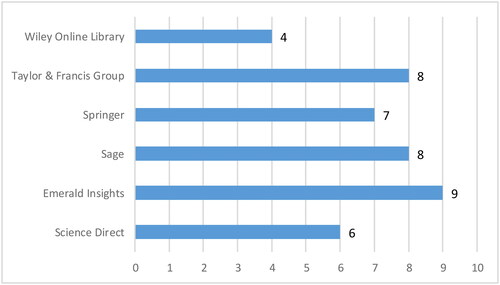Abstract
This study aims to review recent writing on the dynamic capabilities view practices of business firms to examine the concepts and create a more thorough theoretical description from a conceptual standpoint. A thorough review of the literature on dynamic capabilities view practice was conducted. The study demonstrates that there are scattered studies across countries about the conceptual practices of dynamic capabilities practices recently within the scope of the review (2019–2023). Many methodological (exclusive search) constraints exist in this review, which may limit how well it can be used with additional case studies in a relaxed period. The dynamic capabilities view is an essential part of developing transformative and advanced institutions relevant to strategic management orientations in many aspects of the institutions. It is the first of its type to use a methodical analysis of dynamic capabilities and the practices of businesses across many nationalities to demonstrate how the perspectives relate to one another by carefully reviewing a large body of research in strategic management and management disciplines. Both ideas have not been investigated or addressed in tandem before. A full understanding of the current state of dynamic capabilities view concerning businesses was handled on a single platform through developing an in-depth knowledge of dynamic capabilities oriented to business model conceptualization.
REVIEWING EDITOR:
1. Introduction
As a strategy paradigm, the dynamic capabilities view draws inspiration from various theoretical schools, particularly resource-based and evolutionary views. The operational (or ordinary) capabilities perspective, which was previously focused on procedures and practices aimed at optimising the utilisation of the company’s current resource base, has given way to the dynamic capabilities view (Pfajfar et al., Citation2023). On the other hand, dynamic capabilities are defined as how to use organizational resources and strategic exploration to enable sustained performance and superior performance. Resources and incremental creativity must be valued, imperfectly sustained, and modified over time (Furnivall et al., Citation2019).
Dynamic capabilities unfolding from shifting the business activities of modern firms from the outbound to the new opportunities of market positioning and from transaction to packaging new products and services boost the competitiveness of brick-and-mortar of different business companies (Abrate et al., Citation2020). Organizational capabilities are differentiated in open creativity and their relationship with dynamic capabilities, identifying the significance of dynamic capability in the strategic management of internal and external knowledge of certain organizations as a source of competitive advantage (De Aro & Perez, Citation2021). Services offering organizations contribute a key role in the development of dynamic capabilities pertinent to understanding storage, acting as knowledge repositories (Gonzalez & Melo, Citation2019). Many innovation-focused skills for achieving more dynamic resilience were discovered to have a favourable effect on business performance (Dovbischuk, Citation2022). Dynamic capacities mediate the interaction between family influence and the inventiveness of digital business technology and the moderating impact of environmental dynamism (Soluk et al., Citation2021).
The model of appropriate governance mechanisms with external partners in response to the number of risks, which will tend to vary depending on the types of open innovation and creativity function, is referred to as a dynamic capability (El Maalouf & Bahemia, Citation2022). When compared to state-owned businesses, private corporations, which are more flexible, are better able to deal with the uncertainties of a shifting environment. These businesses can overcome their geographic location thanks to their innovative and absorptive capabilities (Panibratov & Klishevich, Citation2020). Because organizations are complex systems, different combinations of capabilities and their relationships as a dynamic capabilities system produce a long-lasting competitive advantage that cannot be explained by any one dynamic capabilities acting alone (Sunder M & Ganesh, Citation2021).
In Merchandising, the dynamic managerial capability is put to use. Increased operational workloads and a lack of time to implement dynamic managerial capability in the future (Kevill et al., Citation2021). Conflicting theories and conclusions have arisen from research on the nature and importance of firms’ dynamic capacities. Contingency theory, according to some academics, may enhance our understanding since the environment in which dynamic skills are used may have an impact on their worth (Asija & Ringov, Citation2020).
Even though social media use has become widespread, previous research has been unable to explain how to strategically employ social media tools to add value to businesses in the increasingly digital world of today by adopting a perspective on dynamic capabilities (Garrido-Moreno et al., Citation2020). Dynamic capabilities aid media companies in adapting to rapidly changing environments. The dynamic capabilities framework assists media companies in effectively responding to changing environments. The dynamic capabilities conceptual framework has implications for media strategy practice (Murschetz et al., Citation2020).
The market is extremely dynamic when a firm’s ability to respond spontaneously to market changes is critical to its survival; absorptive capacity can directly deliver the result to leverage the firm’s performance without having to reconfigure its resources, as indicated by the theoretical stance of dynamic capability (Senivongse et al., Citation2019). The competitive advantage of these businesses is significantly and favorably impacted by dynamic capabilities. It is still difficult to fully comprehend the advantages of open innovation and any potential limitations. Provide a dynamic capabilities framework to better comprehend open innovation’s strategic management, which can subsequently be used to better explain both open innovation’s success and failure.
The findings confirmed that dynamic capabilities can be viewed as internal drivers that promote long-term business model innovation, from conception to change or dissemination. Provides insights into the archetypes of sustainable business model innovation and guidance on how to incorporate them into the organization’s strategic activities aimed at the various dynamic capabilities to achieve sustainable innovation. Dynamic capability is understood to be ingrained in the purpose, the built memory and selves of human actors in the organization, and the collective endeavor that creates the organization through deliberative processes through the explanation of one such organizational space. Developing dynamic capabilities through content analysis of presidential speeches and exploratory case studies of China’s high-speed rail and semiconductor industries. However, there is no mutual agreement among strategic management scholars and practitioners about the dynamic capabilities practices and less focus by scholars across the world pertinent to Africa and America with the specified year (2019–2023) in this review, as evidenced in the findings.
Based on the fundamental flaws of past reviews and research articles written by academics at various conceptual levels, this study intends to address the following critical review problems.
What is the level of dynamic capabilities view distribution at the country level for those selected articles?
What types of research approaches have been used in those articles to collect research data?
In which databases were journal articles of scholars published?
What are the practices of dynamic capabilities in different firms?
Where are dynamic capabilities views of firms practiced in countries conducted?
In which year did scholars investigate mostly dynamic capabilities views from different perspectives?
Review questions
2. Conceptual framework of dynamic capabilities view
Under the context of theoretical structures based on resource and strategic management, dynamic capabilities research is expanding. Given the established effect that dynamic capabilities have on business performance (Dejardin et al., Citation2022). Starting from the notion that organizations need dynamic skills to change with their surroundings (Riviere et al., Citation2021). With the importance of business sustainability being emphasized, it is important to consider long-term organizational resilience that would enable sustainable competitiveness through dynamic capabilities in the face of technological advancements, resource depletion, and rising stakeholder expectations (Karman & Savanevičienė, Citation2021).
The theory of dynamic capabilities aids in identifying the procedures used by a company and its community to overcome challenging circumstances. Dynamic talents are employed by businesses, communities, and times of dynamism to recognize, seize, and transform resources and opportunities (Cabral & van Winden, Citation2022). Developing the necessary capabilities is a crucial strategy that business companies must take into account if they want to endure the rapid technological change that the fourth industrial revolution will bring about (Aghimien et al., Citation2021).
It is a good idea to have a backup plan in place in case you need to cancel your service. Advancing the idea of supply chain hyper agility and establishing its roots, from the viewpoint of dynamic capabilities (Raj et al., Citation2023). Although there is broad agreement that dynamic capabilities are essential to the success of mergers and acquisitions, little is understood about how these capabilities might support an acquirer’s innovative business model (Čirjevskis, Citation2019). These empirical findings offer fresh perspectives on the dynamic capacities necessary for a corporation to transition more smoothly from traditional process innovation to digitally enabled process innovation. The dynamic capacities are limited in the research of the process industries in the context of process innovation and digitization (Chirumalla, Citation2021).
The transition to more sustainable business practices is mostly driven by the scalability of circular business models. They are investigating the microfoundations of dynamic capacities related to initiative scaling (Sandberg & Hultberg, Citation2021). According to a dynamic capability lens, a company’s innovative capabilities have an impact on eco-innovation. Innovative capabilities and eco-innovation are not only connected but also complementary, which helps eco-innovation develop in the future (Arranz et al., Citation2020). Although environmental and social goals have been acknowledged as important ones for small- and medium-sized businesses, the literature has not yet explained how these goals might be met along with consistent economic results. On the other hand, dynamic capabilities and strategy combine to create and refine a defensible business model, which guides organizational transformation shown in (Teece, Citation2018). Therefore, this study deals with how dynamic capabilities (identify opportunities, design, and refine business model; commit resources, realign structure and culture) influence organisational strategies (anticipate competitor reactions, defend intellectual property).
Figure 1. Dynamic capabilities with strategy.
Source: Adopted from (Teece, Citation2018).
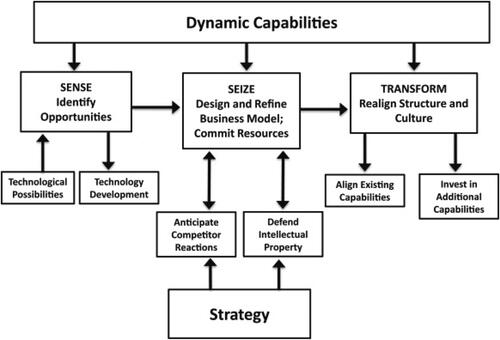
Figure 2. Article selection (PRISMA Framework).
Source: Lim and Rasul (Citation2022).
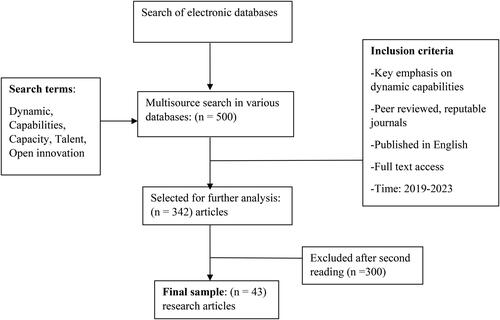
3. Research method
A systematic literature review was used in this study to identify articles that define or conceptualize the concept of dynamic capabilities. We preferred the systematic review literature method because of the advantages it provides over narrative and meta-analysis. Some aspects of this approach have found acceptance in the social sciences. Recently, the approach has been thoroughly examined to determine its applicability to the dynamic capabilities perspective. A systematic review contributes to the development of a reliable knowledge base by aggregating information from various studies. This study examines how these concepts differ and what they have in common, and this review addresses both of these points.
3.1. Search strategy
This systematic literature review identified relevant research articles, allowing for a transparent, documented research process with inclusion and exclusion criteria. The process of conducting a systematic review includes the following steps: developing research questions, establishing guidelines for collecting literature, deciding on inclusion and exclusion criteria, creating a comprehensive search plan for finding literature, creating a codebook for classifying and describing literature, coding the literature, and synthesizing the literature. This review investigates the literature to determine whether there is a positive relationship between technology and human resource management practices concepts. Specifically, the search strategy identified research articles that combine dynamic capabilities view and business practices. To do so, inclusion and exclusion criteria must be used.
3.2. Sample selection process
The initial search yielded research articles, 500 of which were in English. depicts an overview of the selection process flow diagram.
3.2.1. Selection of databases
The study employed a three-step procedure to identify scholarly research articles. First of all, we selected key business, management, and social science databases. To achieve the objective of the review, seven dominant academic databases indexed in Scopus such as Emerald Insight, Taylor and Francis, Springer, Sage Online, Google Scholar, Wiley Online Library, and Science Direct were explored to identify articles related to dynamic capabilities perspective. Thus, the selection of the databases is mainly based on the variables indicated in the topic by evaluating each article downloaded using systematic literature review techniques.
Therefore, selection of the databases primarily used PRISMA framework adapted from (Lim & Rasul, Citation2022) as depicted in .
3.2.2. Inclusion and exclusion criteria
The review was conducted based on inclusion and exclusion criteria. The inclusion criteria consist of search boundary, year of publication, language, and search variables. The search boundary focused on peer-reviewed and reputable journals of social sciences, management, human resource management, and management. Research articles published from 2019 to 2023 were the focus of the search strategy.
The year 2019 was used as a baseline of the earliest date of interest because hoped that it would fulfil a publication made and more paradigm shift was taken from a dynamic capabilities perspective. The search for studies was limited to English-language research articles. The study used search engines using the Boolean technique and using search terms on “Dynamic,” Capabilities’’, “Capacities’’, “Talent”, “Open innovation,” and “Dynamic capabilities”.
The exclusion criteria include relevance, quality, and duplication. It was done through critical reading of abstracts and conclusions of downloaded articles databases mentioned in this study. The relevance of the articles was determined by deciding whether articles fit a keyword used as a search string and to ensure the quality; the study excluded unpublished articles, article contents, Book reviews, Miscellaneous, Books, Book chapters, Working paper series, and Conference papers to enhance the findings of this review. Duplicated articles were excluded by assigning codes for each article and manual detection.
Finally, the researchers carefully screened articles; after checking and deleting duplicates, we created a publication pool with 500 articles. We screened these articles by using several inclusion and exclusion criteria. A total of 43 articles met the inclusion and exclusion criteria. The review procedure enables the study to create a systematic, trustable, replicable, and transparent method of data collection and analysis of the paper followed during article selection for a systematic review.
3.3. Data analysis
We used a descriptive and content analysis concerning review questions predefined at the first stage of the review step. The descriptive analysis was conducted using the categories from the data mining form. It was done through tabulation of the review matrix, particularly for the discussion of study characteristics results using points such as databases, type (conceptual, empirical, or review), and level of analysis. The descriptive analysis helps the study’s characteristics subsection and provides the reader with a brief background of the articles that have been reviewed in this study. Besides, content analysis was used as a data analysis technique. Encoding issues were addressed in the articles, and an interpretative approach was used to analyze the results of the study manually. This section begins by describing the case areas, contributions, limitations, research approaches, and year-wise and journal-wise distribution of the 42 identified journal articles. The section then describes the conceptualizations of the dynamic capabilities view and business practices studied by previous research scholars.
4. Result and discussion
This section begins by outlining the conceptual linkages between the 42 chosen journal research articles by explaining the country-wise distribution, study approach-wise distribution, year-wise distribution, database-wise distribution, and journal-wise distribution. Next, this section discusses the conceptualizations of dynamic capabilities that were developed by earlier research.
4.1.1. Country-wise distribution of dynamic capabilities firm practices
depicts the publishing distribution by country for the 42 research articles that were chosen and published pertinent to dynamic capabilities. Five of the 43 articles that were chosen, or the majority of them from the perspective of dynamic capabilities, were examined in India. Comparatively, four studies on the subject were undertaken in Germany and published in four different study articles. Three studies on the views of dynamic capacities have been done, and they are from Brazil, Spain, Sweden, and the United Kingdom. On the other hand, two studies on dynamic capacities in various industry settings were conducted in China, Russia, Taiwan, and The Netherlands, respectively.
Figure 3. Country wise distribution of dynamic capabilities practices.
Source: Own construction, 2023.
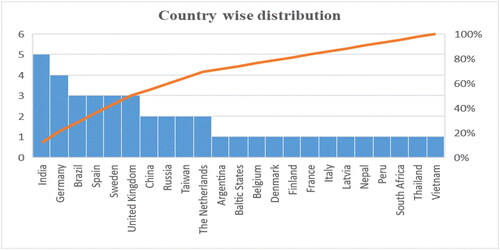
The research on dynamic capabilities perspectives was finally examined in one article each by Argentina, the Baltic States, Belgium, Denmark, Finland, France, Italy, Latvia, Nepal, Peru, South Africa, Thailand, and Vietnam. As a result, we conclude that dynamic capabilities research projects that are completed within the required time frame are less common in Africa, America, and Eastern Europe. This can indicate that there is a regional requirement for future researchers to take into account a geographic gap to examine this idea relevant to the dynamic capabilities perspective.
4.1.2. Types of research approaches
displays 42 research articles that were chosen for systematic literature analysis and published in various respected journals. The articles are about an investigation of the dynamic capabilities perspective. For the benefit of the scientific community and practitioners, the study demonstrated how many of the 42 research articles used the various research methodologies or types described above. 48% of studies on previous researchers’ study methodologies on viewpoints on dynamic capabilities use a qualitative research strategy. Additionally, a qualitative technique was employed as the second study methodology by academics, accounting for (36%). At the same time, a few studies (9%) used the mixed approach, and seven per cent (7%) used the review method, respectively, in their studies.
Thus, we conclude that researchers who emphasized the dynamic capabilities perspective utilized less triangulated procedures in their research methodology.
4.1.3. Year-wise distribution of publications on dynamic capabilities
Academic research publications grouped from 2019 to 2023 based on published years to find trends in dynamic capabilities business firm practices. shows that between 2019 and 2021, growth in the number of publications with dynamic capabilities started. The number of research articles on dynamic capacities, however, drastically increased between 2022 and 2023. However, the study demonstrates that there will be an exponential increase starting in 2020 and 2021 and a propensity for declining growth starting in 2023. This shows that there is a need to raise intent and interest concerning dynamic capabilities perspectives concepts in a different industry setting in a variety of company conditions.
4.1.4. Research databases
The most popular academic research databases between 2019 and 2023 were identified by this study (). Emerald insight was used to publish the majority of academics’ research papers (9 of 42 publications from the 42 research databases were chosen as a finding). The second and third best research databases, respectively, are Sage and Taylor and Francis, which each account for 8 research papers throughout a certain time span relevant to dynamic capacities. However, over the periods covered in this review, academics who accessed Springer (7), Science Direct (6), and Wiley Online Library (4) took into consideration publications on the dynamic capabilities perspective in the scientific community. We can conclude that Emerald Insight paid more attention to the research on dynamic capabilities than other research databases.
4.1.5. Journal-wise distribution of articles
The purpose of this description is to monitor the distribution of papers from 2019 to 2023 based on the names of journals that are regarded to be dynamic capabilities perspective research publications. We chose 42 reputable journals with peer reviews and Scopus indexing that had research articles on the perspective of dynamic capabilities under diverse areas (). This figure may give the scientific community hope who are worried about choosing a publisher for studies on the dynamic capacities perspective in the future. From among these credible papers, two articles on dynamic capabilities were accepted by five journals on an equal basis (see ). The remaining journals each accepted a single issue as detailed in . We conclude that if the same interest in the dynamic capabilities perspective persists in the future, researchers may identify other journal names besides those chosen in this study.
Table 1. Lists of journals across articles.
4.1.6. Dynamic capabilities view practices in 2019
Dynamic capabilities practice in 2019 demonstrates numerous industries and commercial contexts (). From small- and medium-sized businesses to sophisticated companies, dynamic capabilities practices play a crucial part in redefining how they carry out their daily tasks. Additionally, it contributes to areas such as social ventures and conventional travel companies. Additionally, post-socialist emerging markets and open innovation business models benefited from dynamic capabilities. We conclude that during the stipulated year, all company sectors, from small to technologically oriented software enterprises, were increasingly interested in the practices of dynamic capabilities.
Table 2. List of dynamic view practices in 2019.
4.1.7. Dynamic capabilities view practices in 2020
In several concepts and business areas, displays dynamic capabilities view practices for the year 2020. The role of dynamic capacities is used in various business contexts around the world, including in the given year in the Russian business sector, open innovation in China, and the Taiwanese ICT sector. Additionally, there were other areas where the dynamic capabilities concept was applied, including social media use, system thinking, lean thinking, smart manufacturing, media management, and new international enterprises. Even practices for smaller firms that use dynamic capabilities are viewed. Thus, we conclude that in 2020, the dynamic capabilities view was crucially implemented in advanced sectors and current production models.
Table 3. List of dynamic view practices in 2020.
4.1.8. Dynamic capabilities view practices in 2021
shows how many industries and concerns will be represented in dynamic capabilities view practices for the year 2021. Dynamic capabilities have a crucial influence on how practices are viewed in various commercial contexts, like the recent Covid-19 outbreak. Some corporate sectors, including open innovation, smart cities, digital businesses, and the process industry, were utilizing the dynamic capabilities perspective. The fashion industry, supply chain, family-owned businesses, construction organizations, and organizations in the Baltic region have all been the subject of research that has focused on the use of dynamic capabilities to implement business plans. We conclude that the dynamic capabilities view was a key idea for strategic research in various business-level industries and modern organizational practices in 2021.
Table 4. List of dynamic view practices in 2021.
4.1.8. Dynamic capabilities view practices in 2021
shows how practices related to the dynamic capabilities view were seen in seven research articles published in 2022 and one article published in 2023. These studies looked at the use of dynamic capacities at the firm level in logistic services, tourism enterprises, and the Covid-19 pandemic. On the other side, are small and medium businesses, sole proprietorships, and the supply chain industry. This suggests that there are currently dynamic capabilities relevant to advanced organizations as well as individual businesses. However, the research currently being done on dynamic capabilities is insufficient and calls for additional studies to be included in experts’ future research agendas.
Table 5. List of dynamic view practices in 2021.
5. Discussions
According to several studies, improving sustainability performance should involve ongoing adjustments that are made possible by dynamic capabilities (Eikelenboom & de Jong, Citation2019). Firms are experiencing increased dynamism as a result of rapid technological development, digitalization, and sustainability requirements, which are opening up new opportunities for ecosystem innovation (Linde et al., Citation2021). The impact of dynamic capabilities (DCs) on service innovation goes on to look at the mediating roles that general and specialized human capital play in this connection (Tsou & Chen, Citation2020).
The occurrence of dynamic capacities in new, global initiatives from emerging markets. Although the literature on how emerging markets can create dynamic skills to get over resource shortages and legitimacy problems is fragmented, this review may provide basic ground (Buccieri et al., Citation2021). Business management skills needed to combine the architectures and collected reusable code with the ability to implement continuous improvement methods are the main emphasis of dynamic capabilities (Obaya et al., Citation2020).
Despite attempts by key stakeholders to keep abreast of all the contemporary challenges, waste of disaster relief supplies along the supply chain, which puts pressure on already limited resources, is a major concern. With dynamic capacities serving as the overall theoretical lens, we derive conclusions that support efficient management (Mishra et al., Citation2022). A firm’s digital transformation is a three-stage process that includes process digitalization, product and service digitalization, and business model digitalization and triggers for each stage, as well as the dynamic capabilities required throughout this process (Soluk & Kammerlander, Citation2021). The analysis of the increase in investment in this activity relative to the company’s whole activity uses a new method to measure dynamic capacity indicators utilizing economic and financial data that uses activity cost elasticity concerning total cost (Jardon & Martinez-Cobas, Citation2021). The impact of the three business resilience aspects from the viewpoint of dynamic capabilities, such as proactive capabilities, reactive capabilities, and supply chain design quality, is the main determinant (Pu et al., Citation2022).
There has been little research into the role of dynamic capabilities in these firms’ global strategies, as well as how these firms develop and use different sets of dynamic capabilities in their foreign operations (Khan et al., Citation2020). The emotional components of the owners were shown to be important for the growth of dynamic skills in this type of firm (Olazabal & Avila, Citation2022). In a dynamic and competitive environment throughout the transition, the majority of maturity models are unable to identify an organization’s dynamic capability or assess this capability (Lin et al., Citation2020). Companies should consider the altered consumer behavior when producing their goods (Nayal et al., Citation2022). Construction of new premises, upgrading of existing facilities, and the introduction of new services are all dynamic capabilities employed for transformational events that have had a significant impact on the businesses operating in the setting (Paavola, Citation2021). The project management skills needed to combine the architectures and collected reusable code with the ability to implement continuous improvement methods are the main emphasis of dynamic capabilities.
6. Practical implications
This study has significant conceptual contributions to academia and business practitioners. The study offers a comprehensive systematic review of 42 identified research articles in management and strategic management insights to reveal how scholars have explored this concept so far and present a route for future research practical implications. Additionally, this study contributes to basic concepts of dynamic capabilities view practices for four years and a few months in 2023. The main contribution of this study starts from identifying how dynamic capabilities view practices to transform the way micro-enterprises, individual-level businesses, and small, medium, and multinational companies operating were changed from the traditional manners to contemporary dynamic business environments. Reviewing main understandings from existing scholars’ conceptualizations of the paradigm and supporting that the conceptual foundations have derived brief discussions, broad in scope and views, derived to advance empirical research on dynamic capabilities view practices. Moreover, this research is thought to be used as a valuable source for researchers in different countries to understand the present circumstances pertinent to the practices of dynamic capabilities view in the field of strategic management for future stakeholder engagements from the traditional manners to digital ways of performing with the application of dynamic capabilities view models and business innovations.
For managers, this research demonstrates the favourable outcomes that organizations can derive by having a proper understanding of dynamic capabilities view and practices in today’s changing business environments. Practicing the concepts of dynamic capabilities view used to revolutionize today’s business way of working to some digital applicabilities neither small nor big business companies. Thus, dynamic capabilities view practices in business industries as vital aspects it plays an imperative role in that concern; this review paper hopefully will benefit practically different firms comprehend that enhanced.
7. Conclusion and limitations
The main purpose of this systematic review was to review contemporary literature on the dynamic capabilities view and business practices’ conceptual applications from different scholars’ perspectives from (2019 to 2023). Dynamic capabilities view practices have not been investigated within a given period specified in most developing and less developed countries. Most of the studies focused on dynamic capabilities view practices in business scenario concepts. This type of disintegration can be misleading, and a systematic review provides a useful analysis to highlight the disintegration and propose boundaries to investigate dynamic capabilities practices better.
However, a systematic review also has methodological limitations, including the level of accuracy and preferences not being the same as those of different scholars. To overcome this type of limitation in this review, we focused on top-known research databases trusted broadly by scholars pertinent to the discipline and the topic of the issue under review. Even if some scopes might have been missed, we trust our conclusion found a reasonable acceptance of redundancy in the databases that we used for this study due to our focus only for 4 years and almost 3 months.
8. Future researchers agenda
Specifically, a future researcher may contribute to the literature older than this study and clarify our findings. Importantly, the findings of this review confirm that despite the relatively established body of literature, there is a lack of focus in less developed and developing countries pertinent to dynamic capabilities view practices in most contexts. There is no mutual agreement among strategic management scholars and practitioners about the dynamic capabilities practices that are almost less emphasized by researchers across the world and are pertinent to Africa and America, with the specified year in this review as evidenced in the findings. We suggest the assignment to future researchers as an input to investigate by relaxing the time and considering the methodological gap identified in this study. Finally, very little research or no research dynamic capabilities view investigation in the financial sector and agribusiness sectors from the findings of this review.
Abbreviations
Not applicable in this document
Ethical approval and consent to participate
Not applicable.
Consent for publication
Not applicable.
Competing interests
We declare that there is no conflict of interest in publishing this paper.
Author’s contributions
The corresponding author administered all the processes, starting with the selection and searching of literature, writing up the report, and policy implications. The author contributed to all investigation activities pertinent to the study, preparation of the report, and corrections based on the reviewers’ comments. The remaining co-authors were my course instructors and supported me during the title selection. Finally, we read the comments and amended changes to the final manuscript.
Acknowledgment
The authors gratefully acknowledge all partners for their constructive guidance and valuable comments in all aspects of the work.
Additional information
Notes on contributors

Robson Mekonnin Shiferaw
Mr. Robson Mekonnin Shiferaw is an assistant professor at Haramaya University, Ethiopia, and a Ph.D. candidate in Management at Jimma University, Ethiopia. Please direct correspondence to [email protected].

Chalchissa Amentie Kero
Dr. Chalchissa Amante Kero is an associate professor of Management at Jimma University and Business and Economics College Dean. Please direct the Co-author to [email protected]
References
- Abrate, G., Bruno, C., Erbetta, F., & Fraquelli, G. (2020). Which future for traditional travel agencies? A dynamic capabilities approach. Journal of Travel Research, 59(5), 1–15. https://doi.org/10.1177/0047287519870250
- Aghimien, D., Aigbavboa, C., & Matabane, K. (2021). Dynamic capabilities for construction organizations in the fourth industrial revolution era. International Journal of Construction Management, 23(5), 855–864. https://doi.org/10.1080/15623599.2021.1940745
- Arranz, N., Arroyabe, M., Li, J., & Fernandez de Arroyabe, J. C. (2020). Innovation as a driver of eco-innovation in the firm: An approach from the dynamic capabilities theory. Business Strategy and the Environment, 29(3), 1494–1503. https://doi.org/10.1002/bse.2448
- Asija, A., & Ringov, D. (2020). Dynamic capabilities: The role of board monitoring and managerial incentives. Business Research Quarterly, 24(4), 268–280. https://doi.org/10.1177/2340944420916309
- Buccieri, D., Javalgi, R. G., & Jancenelle, V. E. (2021). Dynamic capabilities and performance of emerging market international new ventures: Does international entrepreneurial culture matter? International Small Business Journal: Researching Entrepreneurship, 39(5), 474–499. https://doi.org/10.1177/0266242620969682
- Cabral, V., & van Winden, W. (2022). The reaction of coworking spaces to the COVID-19 pandemic. A dynamic capabilities perspective. Service Business, 16(2), 257–281. https://doi.org/10.1007/s11628-022-00489-6
- Chirumalla, K. (2021). Building digitally-enabled process innovation in the process industries: A dynamic capabilities approach. Technovation, 105, 102256. https://doi.org/10.1016/j.technovation.2021.102256
- Čirjevskis, A. (2019). The role of dynamic capabilities as drivers of business model innovation in mergers and acquisitions of technology-advanced firms. Journal of Open Innovation: Technology, Market, and Complexity, 5(1), 12. https://doi.org/10.3390/joitmc5010012
- de Aro, E. R., & Perez, G. (2021). Identification of dynamic capabilities in open innovation. Innovation & Management Review, 18(2), 118–128. https://doi.org/10.1108/INMR-10-2019-0120
- Dejardin, M., Raposo, M. L., Ferreira, J. J., Fernandes, C. I., Veiga, P. M., & Farinha, L. (2022). The impact of dynamic capabilities on SME performance during COVID-19. Review of Managerial Science, 17(5), 1703–1729. https://doi.org/10.1007/s11846-022-00569-x
- Dovbischuk, I. (2022). Innovation-oriented dynamic capabilities of logistics service providers, dynamic resilience and firm performance during the COVID-19 pandemic. The International Journal of Logistics Management, 33(2), 499–519. https://doi.org/10.1108/IJLM-01-2021-0059
- Eikelenboom, M., & de Jong, G. (2019). The impact of dynamic capabilities on the sustainability performance of SMEs. Journal of Cleaner Production, 235, 1360–1370. https://doi.org/10.1016/j.jclepro.2019.07.013
- El Maalouf, N., & Bahemia, H. (2022). The implementation of inbound open innovation at the firm level: A dynamic capability perspective. Technovation, 122, 102659. https://doi.org/10.1016/j.technovation.2022.102659
- Furnival, J., Boaden, R., & Walshe, K. (2019). A dynamic capabilities view of improvement capability. Journal of Health Organization and Management, 33(7/8), 821–834. https://doi.org/10.1108/JHOM-11-2018-0342
- Garrido-Moreno, A., García-Morales, V., King, S., & Lockett, N. (2020). Social media use and value creation in the digital landscape: A dynamic-capabilities perspective. Journal of Service Management, 31(3), 313–343. https://doi.org/10.1108/JOSM-09-2018-0286
- Gonzalez, R. V. D., & Melo, T. M. (2019). Analyzing dynamic capability in teamwork. Journal of Knowledge Management, 23(6), 1196–1217. https://doi.org/10.1108/JKM-08-2018-0478
- Jardon, C. M., & Martinez-Cobas, F. X. (2021). Measuring dynamic capabilities in Russian companies. Post-Communist Economies, 33(6), 661–680. https://doi.org/10.1080/14631377.2020.1793611
- Karman, A., & Savanevičienė, A. (2021). Enhancing dynamic capabilities to improve sustainable competitiveness: insights from research on organisations of the Baltic region. Baltic Journal of Management, 16(2), 318–341. https://doi.org/10.1108/BJM-08-2020-0287
- Kevill, A., Trehan, K., Harrington, S., & Kars-Unluoglu, S. (2021). Dynamic managerial capabilities in micro-enterprises: Stability, vulnerability and the role of managerial time allocation. International Small Business Journal: Researching Entrepreneurship, 39(6), 507–531. https://doi.org/10.1177/0266242620970473
- Khan, Z., Lew, Y. K., & Rao-Nicholson, R. (2020). The role of dynamic capabilities in global strategy of emerging economies’ multinationals. International Studies of Management & Organization, 50(1), 1–4. https://doi.org/10.1080/00208825.2019.1703375
- Lim, W. M., & Rasul, T. (2022). Customer engagement and social media: Revisiting the past to inform the future. Journal of Business Research, 148(April), 325–342. https://doi.org/10.1016/j.jbusres.2022.04.068
- Lin, T. C., Sheng, M. L., & Jeng Wang, K. (2020). Dynamic capabilities for smart manufacturing transformation by manufacturing enterprises. Asian Journal of Technology Innovation, 28(3), 403–426. https://doi.org/10.1080/19761597.2020.1769486
- Linde, L., Sjödin, D., Parida, V., & Wincent, J. (2021). Dynamic capabilities for ecosystem orchestration A capability-based framework for smart city innovation initiatives. Technological Forecasting and Social Change, 166, 120614. https://doi.org/10.1016/j.techfore.2021.120614
- Mishra, J. L., Chiwenga, K. D., Mishra, N., & Choudhary, S. (2022). Extending dynamic capabilities towards lean thinking in humanitarian supply chains. Production Planning & Control, 33(6-7), 655–675. https://doi.org/10.1080/09537287.2020.1834136
- Murschetz, P. C., Omidi, A., Oliver, J. J., Kamali Saraji, M., & Javed, S. (2020). Dynamic capabilities in media management research. A literature review. Journal of Strategy and Management, 13(2), 278–296. https://doi.org/10.1108/JSMA-01-2019-0010
- Nayal, P., Pandey, N., & Paul, J. (2022). Covid-19 pandemic and consumer-employee-organization wellbeing: A dynamic capability theory approach. The Journal of Consumer Affairs, 56(1), 359–390. https://doi.org/10.1111/joca.12399
- Obaya, M., Robert, V., Lerena, O., & Yoguel, G. (2020). Dynamic capabilities in the software and information services industry. A case-study analysis in Argentina from a business model perspective. Innovation and Development, 10(1), 89–116. https://doi.org/10.1080/2157930X.2019.1572098
- Olazabal, V. H. N., & Avila, N. M. G. (2022). Dynamic capabilities in sole proprietorships: theoretical model through grounded theory. Journal of International Entrepreneurship, 20(4), 591–618. https://doi.org/10.1007/s10843-022-00321-2
- Paavola, L. (2021). The role of (dynamic) capabilities in the transformation of a multi-organizational setting. Journal of Evolutionary Economics, 31 (2), 715–748. (). Springer Berlin Heidelberg https://doi.org/10.1007/s00191-021-00722-x
- Panibratov, A., & Klishevich, D. (2020). Dynamic capabilities during the internationalization of MNCs from post-socialist emerging markets. Multinational Business Review, 28(3), 307–331. https://doi.org/10.1108/MBR-06-2019-0052
- Pfajfar, G., Mitręga, M., & Shoham, A. (2023). Systematic review of international marketing capabilities in dynamic capabilities view—Calibrating research on international dynamic marketing capabilities. International Marketing Review, 41(1), 237–272. https://doi.org/10.1108/IMR-12-2022-0276
- Pu, G., Li, S., & Bai, J. (2022). Effect of supply chain resilience on firm’s sustainable competitive advantage: a dynamic capability perspective. Environmental Science and Pollution Research International, 30(2), 4881–4898. https://doi.org/10.1007/s11356-022-22483-1
- Raj, A., Sharma, V., Shukla, D. M., & Sharma, P. (2023). Advancing supply chain management from agility to hyperagility: A dynamic capability view. Annals of Operations Research, 1–32. https://doi.org/10.1007/s10479-022-05158-5
- Riviere, M., Bass, A. E., & Andersson, U. (2021). Dynamic capability development in multinational enterprises: Reconciling routine reconfiguration between the headquarters and subsidiaries. Global Strategy Journal, 11(3), 380–401. https://doi.org/10.1002/gsj.1389
- Sandberg, E., & Hultberg, E. (2021). Dynamic capabilities for the scaling of circular business model initiatives in the fashion industry. Journal of Cleaner Production, 320, 128831. https://doi.org/10.1016/j.jclepro.2021.128831
- Senivongse, C., Bennet, A., & Mariano, S. (2019). Clarifying absorptive capacity and dynamic capabilities dilemma in high dynamic market IT SMEs. VINE Journal of Information and Knowledge Management Systems, ahead-of-print(ahead-of-print), 372–396. https://doi.org/10.1108/VJIKMS-11-2018-0105
- Soluk, J., & Kammerlander, N. (2021). Digital transformation in family-owned Mittelstand firms: A dynamic capabilities perspective. European Journal of Information Systems, 30(6), 676–711. https://doi.org/10.1080/0960085X.2020.1857666
- Soluk, J., Miroshnychenko, I., Kammerlander, N., & De Massis, A. (2021). Family influence and digital business model innovation: The enabling role of dynamic capabilities. Entrepreneurship Theory and Practice, 45(4), 867–905. https://doi.org/10.1177/1042258721998946
- Sunder M, V., & Ganesh, L. S. (2021). Identification of the dynamic capabilities ecosystem—A systems thinking perspective. Group & Organization Management, 46(5), 893–930. https://doi.org/10.1177/1059601120963636
- Teece, D. J. (2018). Business models and dynamic capabilities. Long Range Planning, 51(1), 40–49. https://doi.org/10.1016/j.lrp.2017.06.007
- Tsou, H. T., & Chen, J. S. (2020). Dynamic capabilities, human capital and service innovation: The case of Taiwan ICT industry. Asian Journal of Technology Innovation, 28(2), 181–203. https://doi.org/10.1080/19761597.2020.1719852


